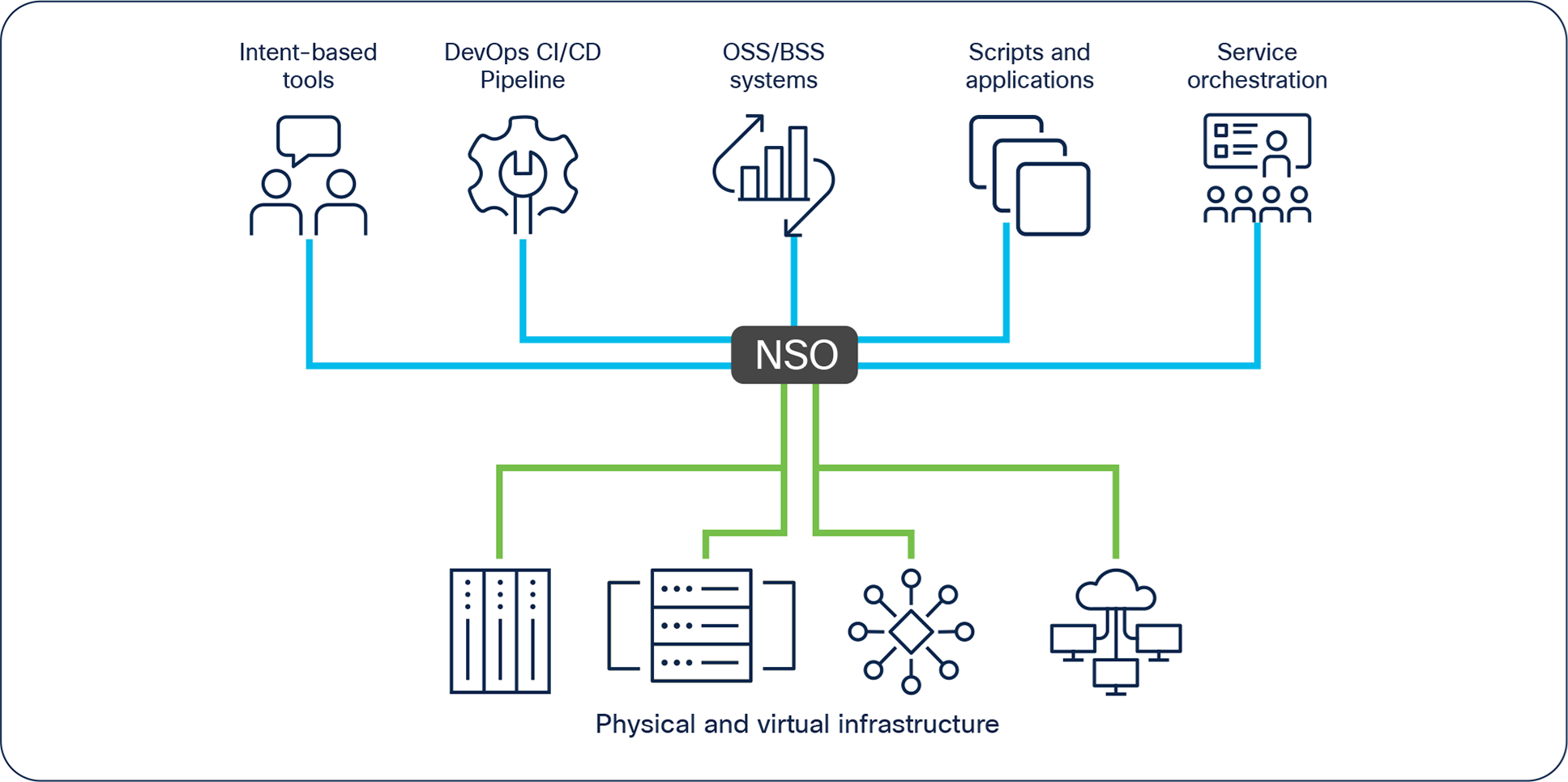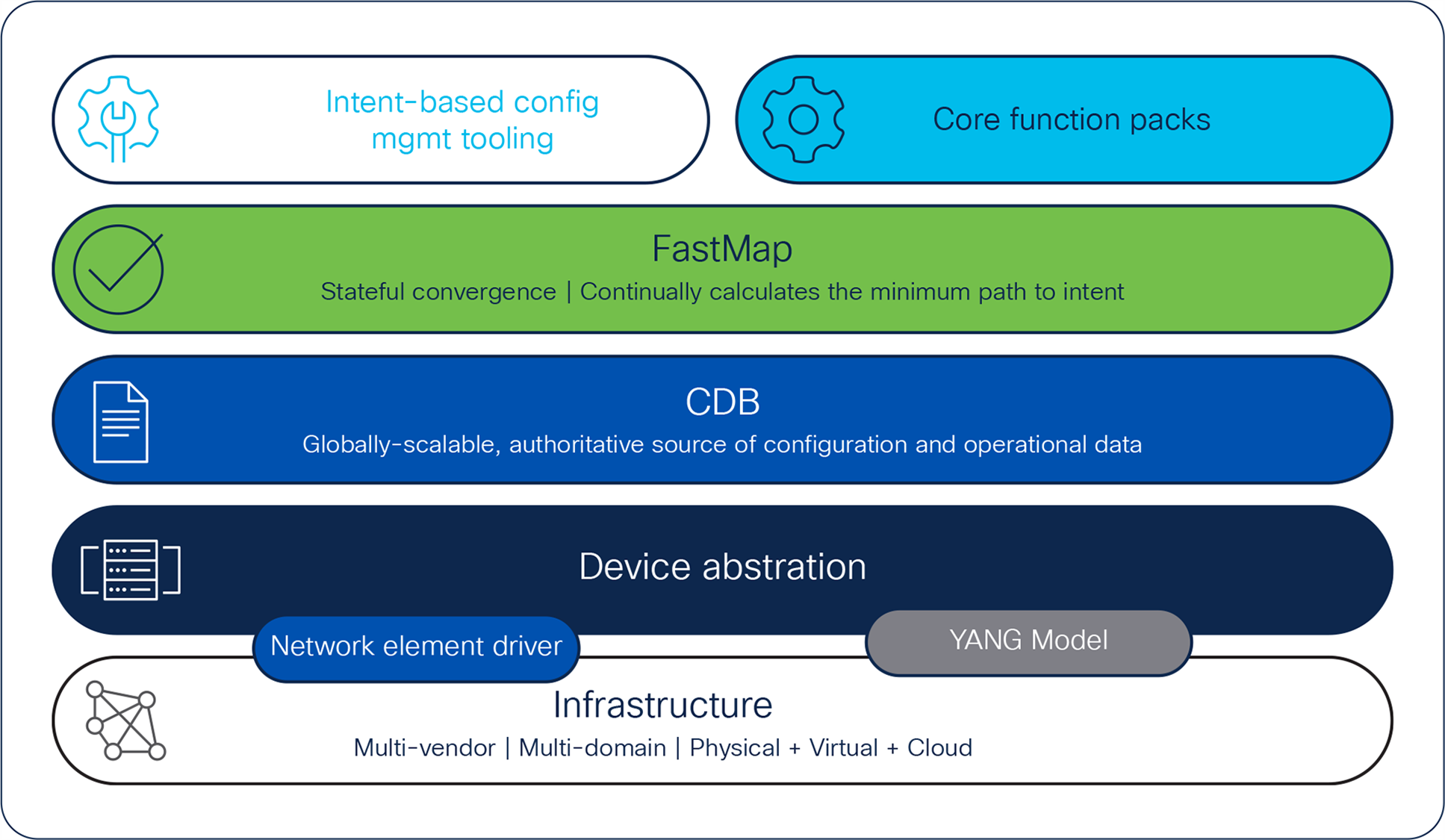Cisco Crosswork Network Services Orchestrator Solution Overview
Available Languages
Bias-Free Language
The documentation set for this product strives to use bias-free language. For the purposes of this documentation set, bias-free is defined as language that does not imply discrimination based on age, disability, gender, racial identity, ethnic identity, sexual orientation, socioeconomic status, and intersectionality. Exceptions may be present in the documentation due to language that is hardcoded in the user interfaces of the product software, language used based on RFP documentation, or language that is used by a referenced third-party product. Learn more about how Cisco is using Inclusive Language.
How quickly can you respond to customer requests? How much friction is there in your order process? How quickly can you roll out new products and services? Your answers to these questions (and how they compare to your peers) can indicate how satisfied your customers feel and how happy your employees are. Automation can give you better answers to these questions.
“With NSO we get the agility to design, refine and repackage network services at the speed of software.”
Pedro López
Director, Telefonica Business Solutions
Robust automation capabilities are generally recognized as a competitive advantage because they can help improve customer experience, increase revenues, and lower costs. However, automation in the real world is complicated. Application and service requirements are myriad and ever-changing while infrastructure can span technologies, vendors, and generations. The ability to bridge these environments is where Cisco Crosswork Network Services Orchestrator (NSO) excels. Almost a decade in production at large, complex service-provider and enterprise environment meeting these challenges has shaped NSO into a leading automation platform in the industry.

Crosswork NSO as a bridge
Nearly every business shares a common set of challenges and opportunities:
● Improve customer experience through low-friction interaction, greater responsiveness, and increased personalization and relevancy
● Lower operating expenses to either hit lower price points in competitive markets or improve profitability where price competition is not a factor
● Find new sources of revenue through new products and services, out-experimenting competitors and leveraging improved customer experiences to increase the lifetime value (LTV) of current customers
Perhaps surprisingly, automation can contribute to success in all three of these areas—the sidebar explains why automation can positive impacts beyond the expected increase the efficiency of operations.
NSO is built around three components (see figure 2):
● A model-based programmatic interface that allows for control from simple device turn-up and configuration management to sophisticated, full lifecycle service management
● A fast, highly scalable, highly available configuration data store that is the definitive source of reliable information about the network
● A device abstraction layer that uses Network Element Drivers (NEDs) to mediate access to both Cisco and more than 150 other-party physical and virtual devices
Taken together, these components allow NSO to provide a single, network-wide interface to all network devices and services—both physical and virtual—using a single-state model and configuration database. Through this common model, NSO acts at the Rosetta stone between applications and service owners and infrastructure operations.
Automation delivers broad benefits.
● By handling monotonous processes that take up the vast majority of operations’ time, it frees your teams to work on higher-value tasks such as better understanding the needs of customers and stakeholders.
● Automated processes are executed in a consistent way so that downstream processes do not have to deal with errors and variability, and customers get predictability and a better experience.
● Automated processes run on demand, at machine speed, night and day. This shortens development, testing, and deployment cycles for everyone. For the organization, this translates to faster time to market, increased productivity, and lower costs.
The NSO architecture provides a number of functional benefits when developing an automation framework:
● A rich and diverse set of northbound APIs and software interfaces from programmatic or RPC-based protocols (such as NETCONF/ RESTCONF) to language bindings such as Java and Python to human-to-machine interfaces, such as a web-User Interfaces (UIs), and a set of Command-Line Interfaces (CLIs). NSO Developer Studio provides an Integrated Design Environment (IDE) that enables fast development of new network services using all capabilities in NSO. This allows straightforward integration into existing business systems and operational tool chains such DevOps continuous integration and deployment (CI/CD) pipelines
● A multivendor device abstraction layer to mediate access to both Cisco devices and more than 1000 other-party physical and virtual devices that to allow automation of multivendor and cross-domain workflows
● Integrated capabilities for maintaining the integrity of the environment, sophisticated troubleshooting of infrastructure and services, and granular auditing and logging.
● Extensibility of the NSO platform with pre-built function packs for use cases like NFVI MANO and management of containerized network functions in a Kubernetes environment or through custom development and customization
Digging a little deeper into NSO reveals a set of capabilities that highlight why NSO is a leading automation solution today.

Crosswork NSO architecture
A true model-driven system
NSO can automatically generate a single, well-defined API into the entire network environment. Using the standardized YANG modeling language, you can model and automate any type of device— layers 1 through 7, physical or virtual, addressed traditionally or via Software-Defined Networking (SDN) overlays. Beyond devices, you can also model any type of service or policy.
Real-time configuration database (CDB)
NSO captures the real-time configuration state of every device and service in the network. In a world where network provisioning and operations teams often work with data that is as much as 70 percent inaccurate, NSO can provide a single, scalable, continuous source of reliable data for the network.
Stateful convergence
To achieve end-to-end automation, an orchestrator should be able to receive the “intent” of the service and translate that to real change in the network. Your networking operations may currently rely on workflow definitions to accomplish this—and may soon find themselves overwhelmed by a constantly growing collection of workflows to account for each unique case. NSO takes a different approach through the concept of state convergence. Using the same common data models and modeling language to describe services and devices, NSO fully automates the creation, deletion, and run-time modification of network services. It maps design-time service definitions to run-time network operations through a single, flexible data model for a service. NSO’s stateful convergence algorithm then derives the minimum network changes required to meet the service definition and executes them.
Multidomain orchestration
Automation tools have typically been bound to a technology domain: a tool for the data center network, a tool for the WAN, a tool for the optical network, and perhaps tools to manage firewalls and other L4–L7 devices. NSO can span multiple technology domains allowing you to create and automate cross-domain service chains much more easily and dependably. Furthermore, NSO does this in a loosely coupled manner so that the operations teams responsible each technology domain can work cooperatively with the teams building the service chains.
Extensibility
Cisco Crosswork NSO is not so much an automation tool as an automation platform—it has the power and flexibility to serve as a substrate for your overall automation and orchestration strategy. To help accelerate you automation plans, Cisco has developed a number of extensions to the core platform, which are discussed in the sidebar on the prior page.
NSO is agnostic to the deployment factor of the network functions (NF) included in a network service. The focus is the intent of the network service rather than the underlying physical structure. To manage virtualized network functions the NSO team have developed functions packs that provides the necessary capabilities needed to automate the full lifecycle of virtual resources, Virtual Machines (VMs), or container-based networking elements as part of end-to-end services. As part of a single service model, NSO can trigger the launch, configuration, and ongoing monitoring and license management of VNFs—both individually and in complex service chains.
Table 1. User benefits
| Role |
Benefit |
| Network or infrastructure engineer |
Use task or platform-level automation to increase efficiency and accuracy and tame complexity during day-to-day operations |
| DevOps or deployment engineer |
Frontline for customer experience—needs robust tooling that can provide end-to-end automation or easily integrate into a larger tool chain |
| App or service owner |
Deliver growth by quickly developing, deploying and iterating new apps and services |
Cisco also offers function packs that extend the core platform to address specific use cases:
NFVO - provides network function virtualization orchestration. Paired with NSO and ESC it forms a full ETSI NFV MANO solution
CNFO - managing the life cycle of containerized network functions (CNF) that runs in kubernetes clusters
T-SDN - automate processes associated with deploying segment routing (SR) services
Routed Optical Networks – automates routed optical networks and connects the IP domain with the optical domain
“The flexibility and open nature of [NSO] will equip us with the tools to innovate new services at a rapid pace and keep ahead of our competition.”
Sadahiro Sato
SVP of ICT Innovation
SoftBank
NSO is part of the Crosswork portfolio of automation tooling built for service providers and large enterprises. Crosswork is designed to help organizations move more quickly and effectively, using speed as a competitive advantage. The portfolio is built around a functional framework with three anchors:
● Visibility – verify and monitor customer experience
● Insights – correlate data and identify trends and patterns
● Action – automate processes to increase accuracy and agility
NSO is one of the primary tools to provide the “Action” capabilities within Crosswork.
The team that built NSO has a decade of experience working side by side with the world’s top service providers and a growing number of large enterprises to help them automate their environments. Those real-world insights have shaped NSO not just in terms of a robust set of automation capabilities but also in areas like scalability and trust, which are equally as important in production environments.
Successful execution of an automation strategy is as much about people and process as it about tools such as NSO. You may find you need to augment your capabilities in these areas as you embark on your automation journey. In support of that, Cisco Services offers a full portfolio of services across the project lifecycle from advisory services to implementation and support to customization. In addition to the professional services offered by Cisco, Cisco Solution Plus partners also offer professional services related to their offers.
Cisco Capital can help you acquire the technology you need to achieve your objectives and stay competitive. We can help you reduce CapEx. Accelerate your growth. Optimize your investment dollars and ROI. Cisco Capital financing gives you flexibility in acquiring hardware, software, services, and complementary third-party equipment. And there’s just one predictable payment. Cisco Capital is available in more than 100 countries.